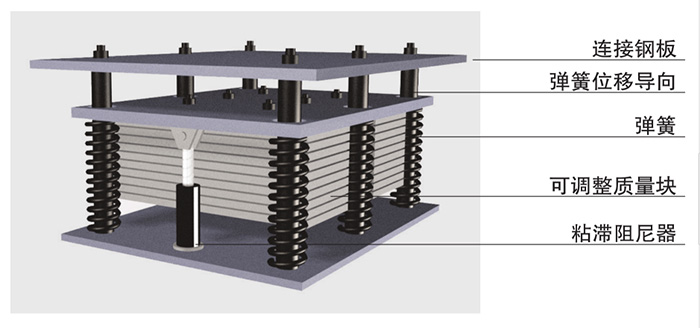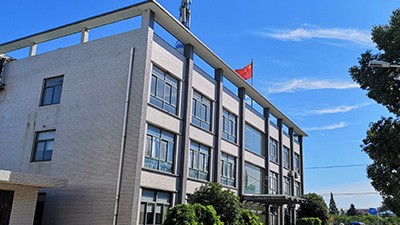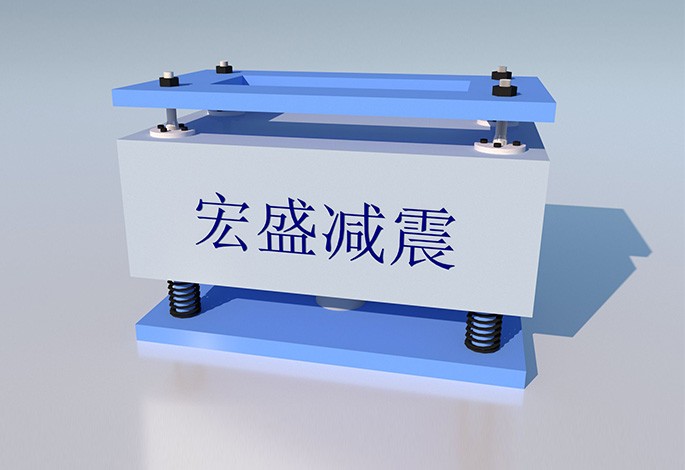1. Basic Concepts
The modern idea of the application of tuned mass damper (TMD) to structures originated from the dynamic vibration absorber studied by Frahm in 1909. It is connected by a small mass m and a spring with a stiffness of k to an object with a main mass M with a spring stiffness of K. Under the action of external harmonic load, it can be shown that when the natural frequency of the connected vibration absorber is determined or tuned to the excitation frequency, the main mass M can remain completely static. By adjusting the mass ratio, frequency ratio and damping ratio of the TMD system and the main structure, the system can absorb more vibration energy, thus greatly reducing the vibration response of the main structure. This is the TMD vibration absorption principle
Tuned mass damper (TMD), through technical means, makes its natural vibration frequency resonant with the frequency of the vibration mode controlled by the main structure, and is installed at a specific position of the structure. When the main structure vibrates, its inertia mass resonates with the controlled vibration mode of the main structure to absorb the vibration energy of the controlled vibration mode of the main structure, so as to achieve the vibration effect of the controlled structure.
2. Composition
The main components of the tuned mass damper (TMD) are mass block, supporting rubber (or supporting guide rail), spring or sling, damper, overload buffer, support and other components, as shown in Figure 1, which can basically achieve permanent use in a non erosive indoor environment.

Figure 1: Schematic Diagram of TMD Company Structure
3. Features
TMD damper has the following remarkable characteristics:
1) Effectively attenuate the vibration response of the main structure: under the condition that the tuning parameters of the structural system such as mass, stiffness coefficient and damping ratio are reasonably selected, the seismic response (displacement and acceleration) of the main structure can be attenuated by 30%~60%, which can effectively attenuate the vibration response of the main structure under various external loads (earthquake, wind, wave, pedestrian load, etc.).
2) The existing structure of the main structure can be fully used as the TMD system, without special tuning device
3) The adoption of TMD system provides an irreplaceable damping measure for some structures that are difficult to take traditional strengthening measures, such as high-rise and super high-rise building structures, high-rise tower structures, long-span structures, offshore platforms and other major structures.
4) Project cost saving: because TMD system has obvious vibration reduction effect on the main structure, the main structure can reduce the member section size, reduce the reinforcement, and optimize the joint connection mode
5) It is not only applicable to the vibration control of new structures, but also applicable to the vibration control of existing buildings.
4. Main Control Basis
Table 3.7.7 of Technical Code for Concrete Structures of Tall Buildings JGJ3-2010 specifies the comfort limits for floor structures of civil buildings. The vertical vibration frequency of floor structure shall not be less than 3Hz, and the peak value of vertical vibration acceleration shall not exceed the limit value in Table 1.
According to our past project experience, the steel structure floor with a span of more than 30 meters and the concrete floor with a span of more than 36 meters are difficult to meet the requirements of Table 1, so special attention should be paid to the review at the design stage. If not, TMD can be added at beam side or slab bottom.
Table 1 Floor Vertical Vibration Acceleration Limit
| Activity environment |
Peak acceleration limit(m/s2) |
|
|
Vertical natural frequency≤2Hz |
Vertical natural frequency≥4Hz |
|
|
Residential and office |
0.07 |
0.05 |
|
Mall and corridor |
0.22 |
0.15 |
5. Connection method
TMD is usually connected by high-strength bolts or welding.
6. Layout Method
Tuned mass damper (TMD) can be suspended or supported (upper attached or lower attached) according to the characteristics of its products.
7. Scope of Application
TMD is mainly used to solve the following problems:
1) Wind resistance and earthquake resistance of high-rise and super high-rise buildings.
2) Vertical comfort of large-span structures, footbridges, air corridors or connecting structures.
3) Horizontal and vertical vibration of TV tower, wind turbine tower, offshore platform, etc.
4) Vibration reduction of infrastructure, equipment, etc.
8. Product ID
Specific identification methods of products are as follows:

Example description:
TMD-H-1000-0.6, which means: tuned mass damper, transverse vibration form, mass block weight of 1000kg, tuning frequency of 0.6Hz.
TMD-S-500-0.8, which means: tuned mass damper, vertical vibration form, mass block weight of 500kg, tuning frequency of 0.8Hz.
Our company can customize various types of tuned mass dampers according to different project requirements










